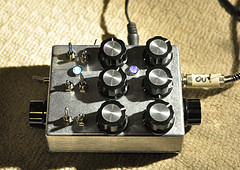Five ways to generate data
Matthew Cornell
December 3, 2010
 I’ve been wondering if there is a small set of categories encompassing the ways we interact with the world to get useful data. Following are some that came to me, which I’d love your thoughts on. Note that all these offer creative opportunities for things to measure based on the consequences of the type of change.
I’ve been wondering if there is a small set of categories encompassing the ways we interact with the world to get useful data. Following are some that came to me, which I’d love your thoughts on. Note that all these offer creative opportunities for things to measure based on the consequences of the type of change.
- Removing something: In a culture that seeks and rewards constant stimulation, simplifying can seem alien. But widening the interstitial spaces in our lives makes room for something new to emerge. This general category of change might include removing a behavior (saying “Ah/Um” in public speaking), a food (cutting out ice cream), or an information stream (RSS feeds). Or it might mean opening up space in other ways, such as temporally (minimizing scheduled activities on weekends), spatially (reducing clutter), or socially (lengthening your pauses in conversations before replying).
- Adding something: The twin to taking something away is obvious, but there are plenty of novel applications. These include installing a new kind of thinking (e.g., CBT), extending your social circle (introduce yourself to one new person a day), or changing your surroundings (how about daily trips to a museum to surround yourself with inspirational art?)
- Making the invisible visible: As subset of adding, I’m intrigued by structuring our environments to make something that’s intangible more noticeable. Applications of what’s known as an Information Radiator in Agile software development, these kinds of changes can take many forms. You might make explicit your power consumption or pollution (how about adding sulfur or bright red coloring to car exhausts?) The idea is that these changes can be eye-openers that stimulate changing our behavior.
- Structuring the environment: Since environment structures behavior, it is natural to experiment with changing our surroundings and noticing the impact how how we act. Health possibilities abound, such as taking the stairs instead of the elevator, or parking far away and walking. A starting point is to decide what you want to change, and then figure how to set up the path of least (or most) resistance. (A few relevant asides: Check out How Smart Cafeterias Could Fight Childhood Obesity, Alex’s How to Design for Behavior Change, and the classic experiment of fly images on urinals at Amsterdam airports – see Easy Does It – How to make lazy people do the right thing.)
- Simply measuring (Making no change): The final category is the null one – not making any change, just simply recording data. This is a good starting point when you have an intuition that there’s something valuable to mine, but don’t yet have a specific question you want answered. The potential value behind this is a fundamental principle of our work – what I call the “observation -> awareness -> change” cycle (a reverse observer effect?) The hope is that the resulting insights will inform the next step, perhaps trying one of the above.
What do you think? Do these cover your past or current data measurement activities? Can we use these to classify existing self-tracking efforts, or to come up with new ones? What other categories are there?
[Image from crayxax]
(Matt is a terminally-curious ex-NASA engineer and avid self-experimenter. His projects include developing the Think, Try, Learn philosophy, creating the Edison experimenter’s journal, and writing at his blog, The Experiment-Driven Life. Give him a holler at matt@matthewcornell.org)


